Takoyaki, or Grilled Octopus Balls, originated in Osaka and are one of Japan’s best-known street foods. Whether you make a traditional style with bits of octopus or choose creative alternatives, these ball-shaped dumplings are fun to make with your friends and family!
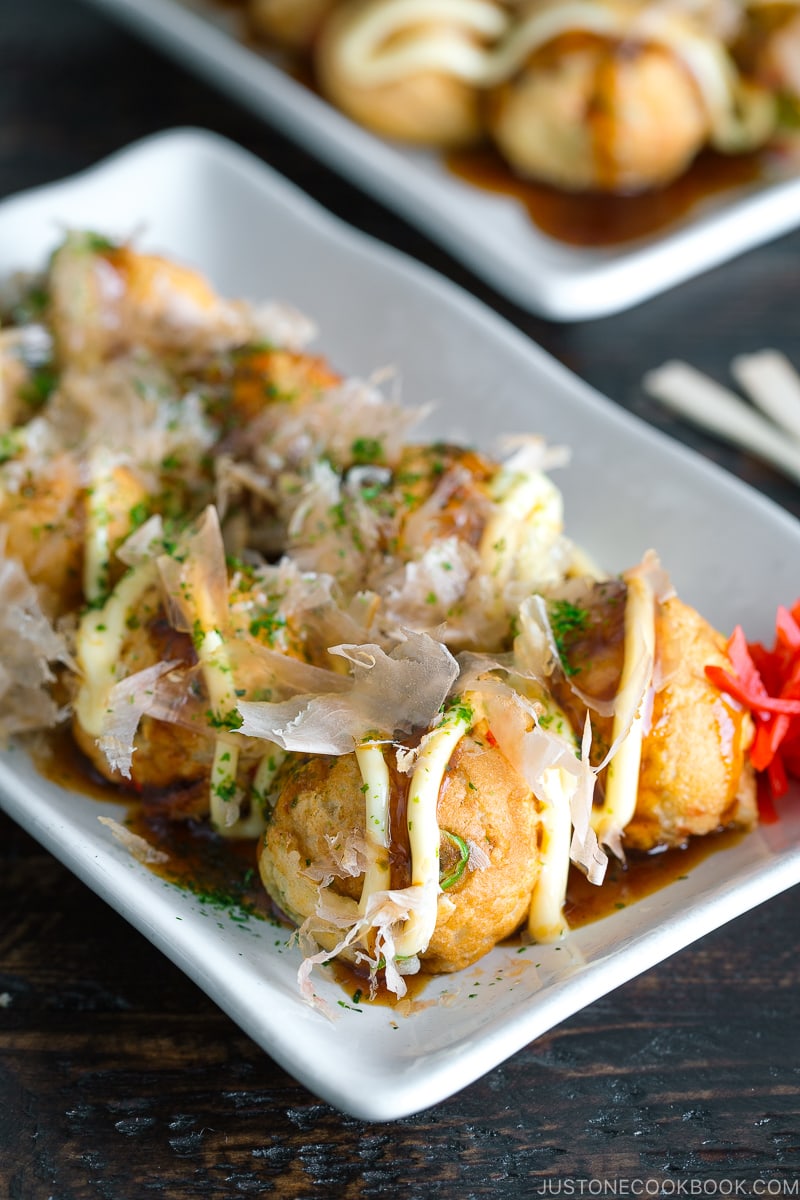
Takoyaki (たこ焼き) is a Japanese snack in the shape of little round balls containing pieces of octopus. Tako-yaki literally translates to “octopus-grilled/fried” and some people may call it “Grilled Octopus Balls” or “Octopus Dumplings”.
What is Takoyaki
Here are some facts about takoyaki.

- It originated and became popular in Osaka around 1935 (according to wiki) and then spread to greater south-central Japan and beyond.
- It’s one of the most popular Japanese street foods along with Okonomiyaki.
- Takoyaki is usually sold by street vendors, convenience stores, supermarkets, food courts, and of course specialty restaurants. In Osaka, takoyaki stands can be easily found throughout the city.
- It is usually served with slightly salty takoyaki sauce, which goes well with beer and other alcoholic drinks. Therefore, many Izakaya restaurants serve takoyaki on the menu.

5 Ingredients for Authentic Takoyaki
There are so many variations of takoyaki throughout Japan. For example, the original Osaka-style does not include any cabbage, but many regional variations (Kyoto, Kobe, Nagoya, Tokyo areas) do. Even though I lived in the Tokyo area, I actually didn’t know they sometimes contain cabbage till now.
Here are the ingredients for the classic takoyaki recipe.
1. Dashi-flavored batter
Very simple. It’s a mixture of Japanese stock Dashi, all-purpose flour, baking powder, eggs, salt, and soy sauce. If you don’t want to make the batter from scratch, you can find takoyaki mix in Japanese grocery stores or Amazon.

2. Octopus
You can purchase cooked (boiled) octopus (tako in Japanese) in Japanese grocery stores. If you are going to make this snack for a big party, you can purchase a whole cooked octopus at an online sashimi store like Catalina Offshore. When I buy a whole octopus, I use it for different dishes, including sashimi, carpaccio, octopus salad (Takosu), and of course, takoyaki.
3. Beni shoga (pickled red ginger)
Small bits of beni shoga (紅生姜), or red pickled ginger, give a nice pop on the color of takoyaki and a little spicy, pungent kick to the dish.
4. Green onion
The batter is yellow, octopus, and beni shoga are red… and now you need green color to make the dish look more appetizing (and delicious)!
5. Tenkasu or Agedama (Tempura scraps)
I often get questions about what Tenkasu does for the dish. We use tempura scraps for hot or cold Tanuki Udon Noodles and Okonomiyaki (even Hiroshima-style). The oil from Tenkasu adds richer and umami flavors, and additional crispness and creaminess inside takoyaki balls.
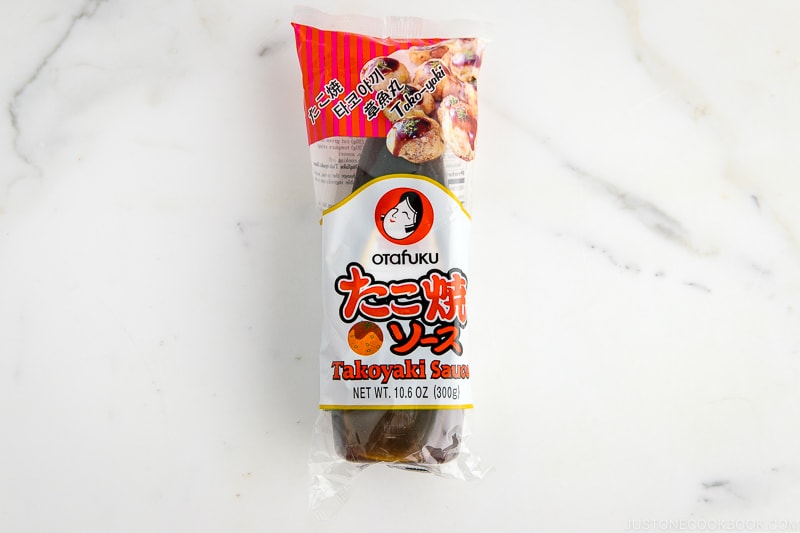
Takoyaki Sauce & Garnish
Takoyaki is served with Worcestershire sauce-like “takoyaki sauce”, followed by some squirt of Japanese mayo. You can:
- Buy a store-bought takoyaki sauce
- Make a quick homemade takoyaki sauce (recipe) with several condiments
Then it’s topped with a sprinkle of a few garnishes:
- Aonori (dried green seaweed)
- Katsuobushi (dried bonito flakes)
3 Tips to Make Perfect Takoyaki
I received many requests for this recipe from JOC Readers (thank you!). To make the recipe as authentic as possible, I asked my best friend Yukako who lives in Osaka. She makes delicious takoyaki at home and she and her husband shared their own recipe with me and JOC readers. Yay! I adapted the recipe a little bit so that some ingredients will be easier to measure.
Tip 1: Don’t be stingy with the oil.
Apply generous oil everywhere (each hole in the takoyaki pan and surrounding flat area). How generous? You should see 1/4 inch (5 mm) oil in each hole. The oil helps takoyaki to have crispy skin and it’ll be easier for you to flip without the batter being stuck.
Tip 2: Generously pour the batter.
When you see smoke coming out of the grill/plate, fill the hole with the batter. If it overflows, that’s okay. Because the entire grill top should be covered with the batter after adding octopus and other ingredients in the hole. If you use a bigger chunk of octopus pieces, you might want to pour just enough to the top of the holes. As soon as the octopus goes in, it overflows naturally.
Tip 3: Flip 90 degrees and stuff in the extra batter.
Break the extra batter around the hole with skewers. Once the bottom of the takoyaki balls is crispy, rotate 90 degrees to let the uncooked batter pour out into the hole. Stuff and push in the extra surrounding dough inside the balls. This will help make a perfectly round shape.
For a home takoyaki grill, each hole doesn’t provide the same amount of heat. Therefore, it’s important to switch around the balls once they are in a ball shape so they’re browned evenly.

Don’t Like Octopus? Here Are Substitutions!
No problem! A lot of Japanese children enjoy different fillings besides pieces of octopus. Here are my suggestions for other fillings.
- Sausages / Bacon
- Canned tuna / Mentaiko (Spicy cod/pollock roe)
- Shrimp / Squid
- Cheese
- Mochi (rice cakes)
- Fish cake (chikuwa/crab sticks)
- Kimchi
- Corn
- Edamame
- Green peas
- Avocado
Various Takoyaki Grills
1. Zojirushi Gourmet Sizzler Electric Griddle + EA-YBC01 Takoyaki Plate (Optional) ($130 + $60)

This is the takoyaki grill pan that I use. I use this electric griddle for Teppanyaki and Okonomiyaki. I switch the hot plate to the takoyaki plate when I make Takoyaki.
2. Iwatani Cassette Gas Takoyaki Device ($100)

3. Iwatani Non-Stick Takoyaki Grill for Cassette Butane Stove ($40)

Do you have this Iwatani cassette feu butane stove already? I use this exact model for doing a hot pot at the table and sometimes filming my YouTube videos. If you have one already, then you can purchase this Iwatani accessory. The grill is non-stick and prevents food from sticking to the pan.
4. Yamazen Takoyaki Device ($45)

5. Ebelskiver (Danish) Pan ($25)

Many JOC readers told me they successfully made takoyaki with an Ebelskiver (Danish) pan or Appam Maker (Indian) as well.
Other Japanese Street Foods
- Yakisoba
- Okonomiyaki
- Taiyaki
- If you are interested in learning about Japanese Street Foods, check out Japanese Summer Festival Foods.
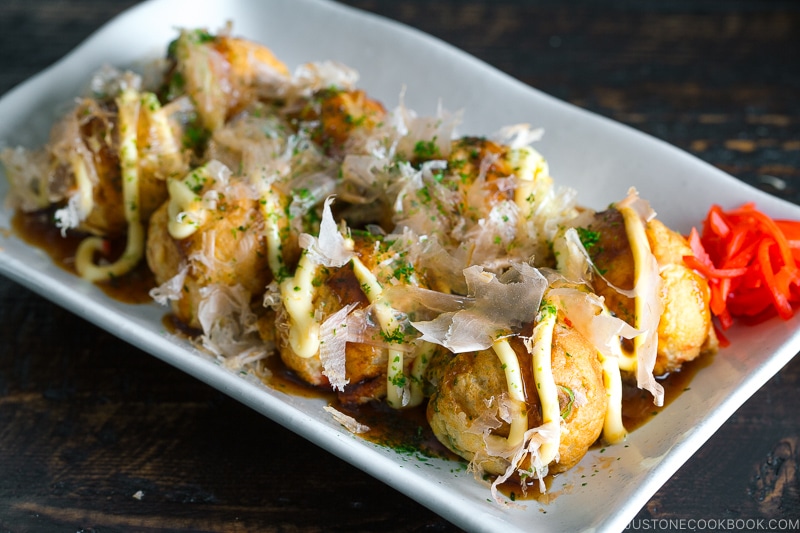
Wish to learn more about Japanese cooking? Sign up for our free newsletter to receive cooking tips & recipe updates! And stay in touch with me on Facebook, Pinterest, YouTube, and Instagram.
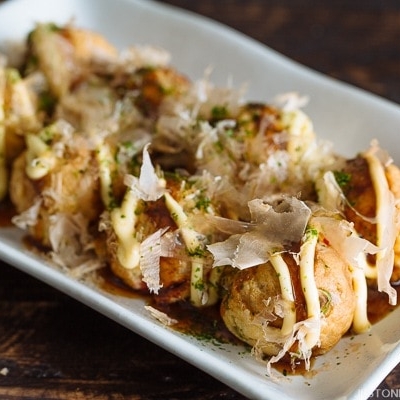
Takoyaki (Grilled Octopus Balls)
Video
Ingredients
- ¼ cup katsuobushi (dried bonito flakes) (I use the type with bigger flakes)
- 2 green onions/scallions
- 1 Tbsp pickled red ginger (beni shoga or kizami beni shoga)
- 4.2 oz octopus sashimi (boiled octopus) (found in Japanese grocery stores; or substitute with sausage, corn, edamame, cheese, small mochi pieces…the choices are endless!)
For the Batter
- 1 cup all-purpose flour (plain flour)
- 2 tsp baking powder
- ½ tsp Diamond Crystal kosher salt
- 2 large eggs (50 g each w/o shell)
- 1 tsp soy sauce
- 1½ cups dashi (Japanese soup stock) (use standard Awase Dashi, dashi packet or powder, or Vegan Dashi)
For Cooking
- 2 Tbsp neutral oil
- ⅓ cup tenkasu/agedama (tempura scraps)
Instructions
- Gather all the ingredients.

To Prepare the Filling
- Grind ¼ cup katsuobushi (dried bonito flakes) into a fine powder. Set aside; we‘ll use this powder when we‘re cooking the takoyaki.

- Cut 2 green onions/scallions into fine slices and mince 1 Tbsp pickled red ginger (beni shoga or kizami beni shoga).

- Cut 4.2 oz octopus sashimi (boiled octopus) into ½-inch (1.3-cm) bite-sized pieces; cut into smaller pieces for kids so they can chew it more easily. I use the rangiri cutting technique.

To Make the Batter
- In a large mixing bowl, combine 1 cup all-purpose flour (plain flour), 2 tsp baking powder, and ½ tsp Diamond Crystal kosher salt and whisk it all together.

- Add 2 large eggs (50 g each w/o shell), 1 tsp soy sauce, and 1½ cups dashi (Japanese soup stock).

- Whisk it all together until well blended and transfer the batter to a measuring cup with a handle (or any other pitcher with a spout for easy pouring.)

To Cook the Takoyaki
- Heat the takoyaki pan to 400ºF (200ºC) over medium heat. Use a brush to generously grease the pan‘s rounded chambers and flat top surface with 2 Tbsp neutral oil. When smoke starts to rise, pour the batter to fill the chambers. It’s okay to slightly overfill the cavities. In the next steps, the batter will likely overflow as you add more ingredients to it.

- Add 1–3 octopus pieces, depending on their size, to each chamber and sprinkle on top the katsuobushi powder that you ground earlier.

- Sprinkle ⅓ cup tenkasu/agedama (tempura scraps), the green onion slices, and the chopped pickled red ginger on top. After 3 minutes or so, when the batter on the bottom has set and is slightly crisp, use skewers to break the connected batter between each chamber. Then, rotate each piece 90 degrees (a quarter turn) toward the bottom of the pan, stuffing the connected dough back into the ball as you turn it. The uncooked batter will flow out from inside to create another side of the ball. After you finish turning them, set a timer for 4 minutes.

- After 4 minutes, rotate them again, starting with the first ball: Turn each takoyaki another 90 degrees toward the bottom of the pan so the remaining uncooked batter pours out into the chamber to complete the ball shape. Home takoyaki griddles don‘t distribute heat evenly, so it’s a good idea to swap the balls around to different chambers so they brown evenly. After turning and cooking for another 4 minutes, they are done.

To Serve
- Transfer them onto a plate and drizzle ½ cup takoyaki sauce and Japanese Kewpie mayonnaise on top. Finish the dish with a sprinkling of katsuobushi (dried bonito flakes) and aonori (dried green laver seaweed) and a side of pickled red ginger (beni shoga or kizami beni shoga). Serve immediately. (But, be careful—they‘re VERY hot inside!)

To Store
- You can keep the leftovers in an airtight container and store in the refrigerator for 3 days or in the freezer for 2–3 weeks.
Nutrition
Editor’s Note: The post was originally published on Oct 20, 2013.
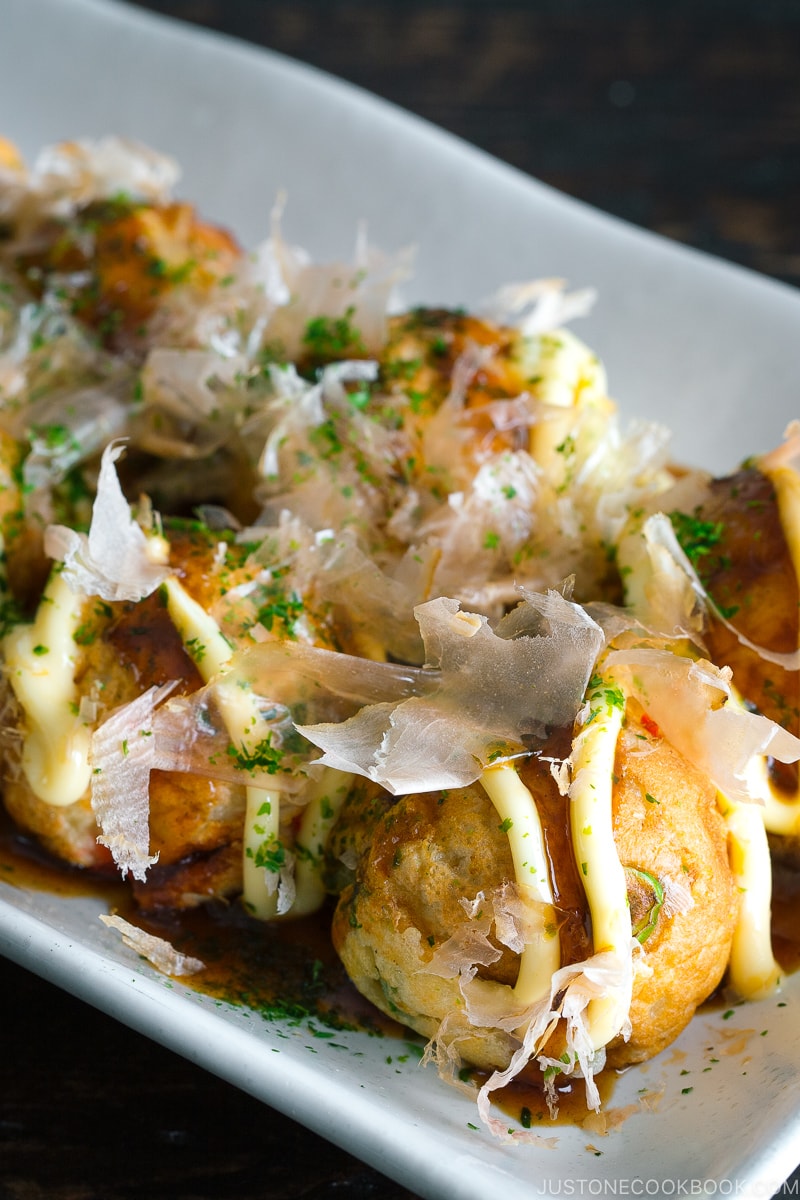






















Hey there! I used a cake pop machine to make mine, because I couldn’t find a takoyaki pan or an affordable aebelskiver pan, here in South Africa. The cake pop machine cost me the equivalent of $17 & they are available everywhere
Thank you so much for sharing this info! Good to hear cake pop machine works! Thank you very much for your feedback! 🙂
Hi! I don’t know why, But i think your takoyaki is very beautiful! I like it!
But do you think, am i need add a little bit dough when cooking to make a perfect circle shape? Because somepeople add a little bit of dought to make a perfect shape. Thank you very much, your web is very helful!
Hi Keylia! Thank you for your kind words! What do you mean by adding a little bit “dough”? You mean batter? You can add extra batter which will make more round and fluffier. Basically fill out the top, and disconnect, and then tuck in all the extras into the ball. I was thinking that might need extra skill, so I didn’t show it in the video. You basically have to collect the extras and before you rotate, you tuck all the extra inside. But the extra part needs to be half cooked, not liquid. Hope this helps?! Hope you enjoy!
I tried this recipe today. It was so delicious, even though my takoyaki came out so small and a bit chewy. I need more practice. Thank you for the recipe.
Hi Tataya! How have you been? Probably it’s doughy which is why it was chewy? Usually takoyaki store batter is VERY thin, but for a beginner, it’s very very difficult to flip. You can slowly adjust to add more liquid so it’ll be less chewy. Takoyaki needs some practice, but once you get used to it, it’s easy to do. 🙂
I tried this recipe last night and even though i had to deep fry them due to no takoyaki pan it was still the best takoyaki I’ve ever had. Thank you sooo much for sharing it.
Hi Tisha! I’m so happy to hear you liked the recipe! I didn’t think of deep frying method! That sounds delicious! Thank you very much for your kind feedback. 🙂
Hi! The takoyaki is very gorgeous! I like it very much, and i want try to make it. But is that octopus “cooked” is that mean “boiled”? Thank you very much for this recipe!
Hi Samantha! Yes, it is boiled octopus. I meant cooked instead of raw. I hope you enjoy this recipe! 🙂
Thank you for the recipe! Takoyaki is my favorite snack food from Japan. I find that using olive oil is not optimal because it burns too quickly.. Do you use vegetable oil for te pan?
Hi Ai! I’m terribly sorry for my late response. Olive oil is probably not good as it has fragrance to it. For Japanese food (unless it’s Yoshoku) I recommend no fragrant oil such as canola, vegetable, and grapeseed oil. 🙂
I tried this recipe and it was awesome. I hope you don’t mind if I link your site to my humble blog for the recipe.
Thank you!
Hi Putri! I just saw your post and I’m so happy to hear you enjoyed this recipe! I’ll share it on my Facebook page. I hope that’s okay with you. 🙂
Hey Nami,
Loved the recipe <3….
I'm from India and most ingredients are unavailable yet i'm gonna attempt to make takoyaki tommorow
(without the tako nor dashi and most Japanese stuffs )
most interestingly i have an "unniyappam" pan which is same as a takoyaki pan 😀
Hi Akash! My friend has that pan but I never thought of using it for takoyaki! This is brilliant. 😀 I hope it’ll be successful! Good luck! 🙂
Hi Nami !
I finally found a takoyaki pan and bought some octopus to make it for dinner… however I should have read your recipe first and did not know I needed tenkasu, which I don’t have. Can I ommit it ?
thank you
It definitely adds more flavor with tenkasu, but if you don’t have it, it’s okay you omit. Next time try adding it. It’s one of important ingredients in Takoyaki and Okonomiyaki. 🙂 So glad you found takoyaki pan. It requires some practice in the beginning but hope you enjoy making takoyaki at home!
I would love to try this some time, I just have a problem… katsuobushi (dried bonito flakes), dashi stock, Tenkasu (tempura scraps) I simply have no idea how to find that… honestly I’ve never heard about those ingredients before… I’m not even sure it’s possible to buy them in my country O.O
I honestly thought that it would be a lot more complicated to make Takoyaki, but it looks pretty easy, if you have the ingredients that is… Turning the Takoyaki or getting a Takoyaki pan is not really a problem since I’m pretty used to making æbleskiver.
You could just add cheese instead of octopus, right? I guess I’ll have to get those ingredients somehow…
Hi Signe! If you’re going to make takoyaki with cheese, you can omit Katsuobushi, dashi, and Tenkasu. I mean it won’t be the same, but you don’t need those savory flavor for cheese as cheese has good flavor already.
Tenkasu or tempura scraps absorbs batter and makes the ball fluffy, which you may not get the same effect without tenkasu.
Dashi, you can replace with water if you like – but lacks the savory umami flavor. But with cheese, it shouldn’t be too bad.
Katsuobushi – I don’t think you need to include or sprinkle katsuobushi on top, so don’t worry.
Hope this helps! I heard from some readers that æbleskiver works for making takoyaki. Good luck! 🙂
Thanks for the recipe. Looks super delicious!
Thank you Joseph! 🙂
I know I’m probably going to horrify the purists but I’m a widower who likes to cook and try new things.
I wanted to try Takoyaki but since i’m cooking for myself, I sure didn’t want to cook an entire octopus nor could I find pre-cooked at my local Asian markets. I also don’t have a Takoyaki pan.
Here’s how I solved the problem:
I used a good quality canned octopus and instead of making traditional Takoyaki balls, I made little pancakes, like the Korean crab pancakes.
Since I’ve never had traditional Takoyaki balls, I can’t compare BUT the little pancakes I made were very tasty. I made then about 2″ in diameter so easy to pick up with chopsticks or fingers.
Hi Casey! I think what you did was very brilliant! Probably the closest thing to Takoyaki. 🙂 I think what you could be missing from the pancake version is that soft dough/batter. When takoyaki is just made, the dough/batter inside the ball is half liquid, not completely hard like pancakes. BUT, I think this is great alternative. I don’t want mine to be too doughy (Takoyaki stand/shop usually makes very doughy takoyaki), so I’d enjoy the pancake version too! Thank you SO much for sharing your version! 🙂
It’s a lot of work to get them into the proper shape. You have to be constantly turning the balls.
I found a video online of the people making them. It’s about 10 minutes of turning. Exhausting!
http://youtu.be/w8YI9erglMw
Thank you for the video, Jeremy! Actually, “keep turning” part is the easy part as it just moves around smoothly. However, when you turn and tuck in the ingredients for the first time… that’s probably the hardest part to make a nice ball shape. The cooking time varies depends on the heat and equipment. So make sure you adjust according to your device. 🙂
Looks amazing! I’m going to try your recipe in my cake pop maker!
Hi Yani! Hope cake pop maker will work! I don’t own one, it’s hard to tell if that works. Let me know if you can use cake pop maker for making Takoyaki. I’m sure other people would love to know. 🙂
Hey Yani! How did it go? I’m about to try it in my cake pop maker as well!
Hi Yani and Amangelin! Let us know if you try! 🙂
i fell in love with these at Shirokiya in Hawaii while visiting my mother in law and i’ve always been so intimidated by them as far as making them. hubby and i tackled the task the other night and they were PERFECT! just as good as Shirokiya! love love love!!! thank you for the wonderful recipe! i can’t wait until our son is old enough to enjoy with us!
Hi Charity! So happy to hear you enjoyed this recipe and takoyaki came out perfect! Thank you for your feedback! 🙂